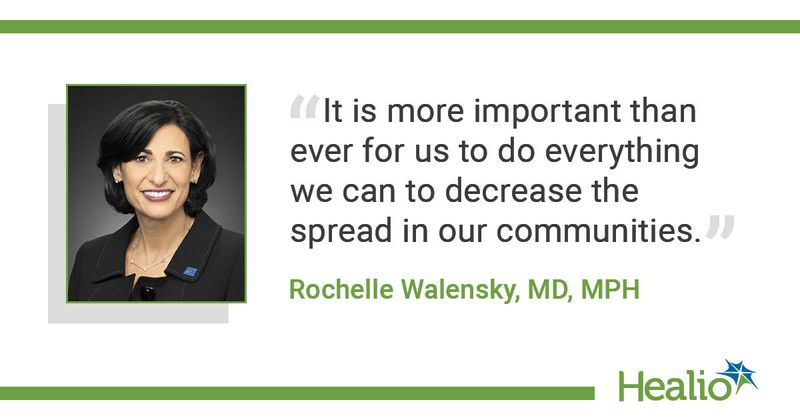Vaccination ‘the path forward’ for the US as pace of rollout continues to increase
As the pace of the COVID-19 vaccine rollout increases in the U.S., experts continued to reassure the public of the safety and efficacy of available vaccines and their importance in addressing the spread of variants and ending the pandemic.
“The direction out of this is vaccination. That is the path forward for us,” Matthew Zahn, MD, FIDSA, medical director in the division of epidemiology and assessment at the Orange County (California) Health Care Agency, said during an Infectious Diseases Society of America press conference this week.

Zahn said the swift vaccine development is “a testament to medical sciences” and their creation “did not involve skipping steps.”
Dial Hewlett Jr., MD, FIDSA, medical director of the Westchester (New York) County Department of Health’s division of disease control, compared the expedited vaccine development for COVID-19 to the rollout of penicillin during World War II. He said the global pandemic motivated collaboration between academia, government and industry in the same way the war acted as a “trigger” for a national collaboration to increase the production of penicillin.
“Although a lot of people will say, 'This was rushed and we did not do everything we would ordinarily do,' everything was done that is normally done,” Hewlett explained. “It's just that because there was focus and resources, we were able to compress a lot of this into a shorter period of time — the result of which was the development of two vaccines rather rapidly, which have shown to be safe and effective.”
White House COVID-19 response coordinator Jeff Zients said during a White House press briefing this week that the weekly allocation of vaccine doses to states increased 57% during the first 4 weeks of Joe Biden’s presidency, and the number of daily doses administered has gone from 1.1 million to 1.7 million.
According to Zients, the administration plans to double the weekly vaccine supply for pharmacies from 1 to 2 million doses, and a federal order has been signed to allow retired nurses and doctors to administer vaccines. Additionally, he said 1,200 members of the National Guard will serve as vaccinators and more than 1,000 military members have been activated to run community vaccination sites.
More than 73.3 million doses of vaccine had been delivered in the U.S. as of Thursday morning, and more than 41 million people had received at least one shot, according to the CDC.
CDC Director Rochelle Walensky, MD, MPH, addressed declining COVID-19 case counts at the press conference, noting that the 7-day average case count has dropped 22% during the past week, to roughly 86,000 cases. However, Walensky also emphasized that the number of COVID-19 deaths continues to “fluctuate,” with an average of 3,076 deaths per day between Feb. 9 and Feb. 15.
“While cases and hospitalizations continue to move in the right direction, we remain in the midst of a very serious pandemic,” she said.
Walensky also addressed the threat of SARS-CoV-2 variants, reiterating that vaccination and other measures like wearing masks are crucial to preventing their spread.
“It is more important than ever for us to do everything we can to decrease the spread in our
communities by increasing our proven measures that prevent the spread of COVID-19,” she said. “Fewer cases means fewer opportunities for the variant to spread and fewer opportunities for new variants to emerge.”
Experts remain concerned about the threat posed by variants, including the B.1.1.7 variant, which the CDC has said could become the dominant SARS-CoV-2 virus in the U.S. by March. Hewlett also emphasized the importance of vaccination to make it less likely the variants will “take over.”
Zahn said further research is needed to determine the vaccines’ effect on asymptomatic transmission.
“The way to demonstrate how well these vaccines prevent asymptomatic infection is going to require larger levels of information,” he said. “Part of it is going to be from public health data that we're gathering right now.”
During a Q&A with JAMA, Walensky said vaccine scale up will need to continue through March, and that there is a concern that mitigation measures among the public will decline when the weather gets warmer. She said the potential for increased transmissibility in some variants will mean “a higher bar to get through” to reach herd immunity.
“The best thing that we can do to prevent these variants in general is to have less disease circulating,” Walensky said.
References:
Marks M, et al. Lancet Infect Dis. 2021;doi:10.1016/S1473-3099(20)30985-3.
The White House. Press Briefing by White House COVID-19 Response Team and Public Health Officials. https://www.whitehouse.gov/briefing-room/press-briefings/2021/02/17/press-briefing-by-white-house-covid-19-response-team-and-public-health-officials-4/. Accessed February 17, 2021.

